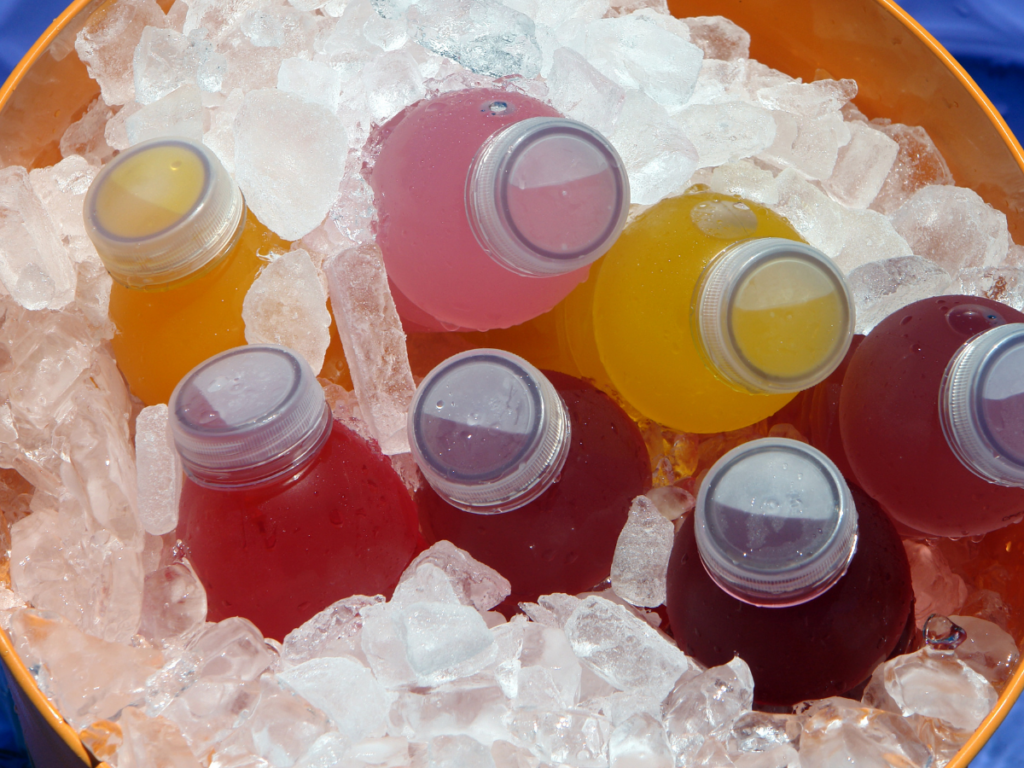Last updated on November 7th, 2024
While Prime Hydration may look like a sports drink, it falls short in providing the necessary carbs and electrolytes that teen hockey players need for peak performance and recovery. Learn why choosing the right hydration option is crucial for sustained energy and proper electrolyte balance on the ice.
When it comes to staying hydrated and fuelled on the ice, not all drinks are created equal. While Prime Hydration might be marketed as a hydration solution, it falls short of the requirements of a genuine sports drink or electrolyte drink. For teen hockey players, understanding when to use a sports drink—and which options truly support their performance—can make a big difference in their energy, recovery, and endurance.
What is a Sports Drink, and When Do You Need One?
Let’s start by clarifying what a true sports drink is, since many products label themselves as “sports drinks” even when they don’t meet the criteria. A true sports drink is specifically formulated to:
- Replenish glycogen stores: By containing 3-8% carbohydrates (from sugar), sports drinks provide fast energy that muscles need during prolonged, intense activities.
- Replace lost electrolytes: A proper sports drink should contain around 110-220 mg of sodium and 30 mg of potassium per 8-ounce serving, essential for maintaining fluid balance, muscle contraction, and energy production.
For hockey players, a sports drink can be beneficial during specific situations:
- Intense activities lasting over 2 hours: If you’re playing back-to-back games, a long practice, or a tournament, a sports drink can help maintain energy and replace lost electrolytes.
- Hot environments or heavy sweating: Sports drinks are valuable during activities that cause significant sweat loss, as they help offset the increased need for electrolytes and fluids.
Why Hydration is Essential for Athletic Performance
For athletes, even mild dehydration (as little as a 2% body water loss) can result in a noticeable decline in:
- Performance and stamina
- Cognitive function and focus
- Recovery time and injury risk
For a 150-pound athlete, this means losing just 3 pounds of water weight during practice—quite common during an intense workout. Maintaining adequate hydration can minimize cramping, help keep joints lubricated, support quicker recovery, delay fatigue, and protect against injury.
The Importance of Electrolytes
Electrolytes are electrically charged minerals like potassium, calcium, magnesium, sodium, and chloride, all of which play vital roles in muscle function, energy production, and fluid balance. Sodium, in particular, is the primary electrolyte lost through sweat and is critical for maintaining proper hydration levels.
If you’re sweating a lot, relying solely on water won’t fully rehydrate you. Adding sodium to your hydration plan, either through a sports drink or salty foods, helps your body absorb and retain the fluids you’re drinking.
Why Prime Hydration Falls Short as a Sports Drink
Prime Hydration may be a popular beverage, but it doesn’t meet the nutritional needs of a sports drink for athletes, especially for teen hockey players:
- Insufficient carbohydrates: Prime Hydration contains only 5 grams of carbohydrates per serving, far below the 3-8% carbohydrate content recommended for true sports drinks. This percentage range is necessary to replenish glycogen stores and maintain energy during prolonged or intense play, as it provides an adequate amount of quick-digesting carbs that the body can readily use for fuel.
- Very low sodium content: At just 10 mg of sodium per serving, Prime Hydration lacks the necessary sodium levels (110-220 mg per 8 ounces) required for effective electrolyte replacement. This low sodium content doesn’t meet the needs of athletes who lose sodium through sweat, making it ineffective for hydration and recovery after intense training or games.
- High potassium content: Prime Hydration contains 700 mg of potassium per serving, significantly higher than the typical 30 mg of potassium in a standard sports drink. While potassium is essential for muscle function and fluid balance, consuming it in such high amounts without adequate sodium can actually create an imbalance in electrolytes. For teen athletes, this imbalance may lead to symptoms like nausea, muscle weakness, or irregular heart rhythms, especially when potassium levels are disproportionately high compared to sodium.
- Unnecessary magnesium content: Prime Hydration also contains 124 mg of magnesium, an electrolyte that, while beneficial in small amounts, is not typically needed in high doses before or during sports. Excess magnesium can act as a laxative, which may lead to gastrointestinal discomfort and negatively impact performance.
Choosing the Right Hydration Strategy for Teen Hockey Players
For most practices, workouts, and games lasting less than 2 hours, water should be the primary source of hydration—especially if you’re incorporating balanced pre- and post-workout meals. Adding salty snacks, such as pretzels or salted nuts, can also help maintain sodium levels without needing a sports drink.
Sports drinks are only necessary in specific cases:
- Prolonged, intense practices, games, or tournaments: During events lasting more than 2 hours or with multiple sessions in one day, a sports drink with 3-8% carbs and adequate sodium helps to replenish energy and electrolytes.
- High-temperature or high-sweat conditions: Heavy sweaters and those training in the heat benefit from the added electrolytes and quick carbs in a sports drink.
- Back-to-back training Sessions: Using a sports drink can support quicker recovery if you’re competing or training again in less than 8 hours.
The Bottom Line: Know When to Use Sports Drinks and Choose the Right One
For teen hockey players, products like Prime Hydration may not provide the carbs, sodium, or electrolytes needed to sustain intense athletic activity. While it may be refreshing, it’s not an adequate substitute for a true sports or electrolyte drink when performance is on the line.
Choose hydration strategies that match the demands of the activity. A true sports drink can help maintain energy, hydration, and electrolyte levels for longer, high-intensity sessions, tournaments, or hot conditions. Water and a few salty snacks are generally all you need to stay fuelled and ready for shorter sessions.



